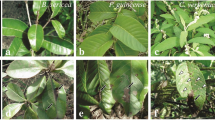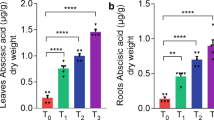Abstract
In order to examine whether the leaves of the Colorado blue spruce (Picea pungens) are damaged or not by traffic pollution, the traits of the anatomy and physiology of its leaves are investigated by exposure to vehicle exhausts in a laboratory experiment lasting 30 days. The results show that both the anatomical structures and physiological traits of the leaves are significantly affected by vehicle exhausts. The anatomical structures, including epidermis, cuticle, palisade, and spongy parenchyma are modified when exposed to the high concentrations (≥0.4 mg/m3) of vehicle exhausts. However, physiological traits such as total chlorophyll content are not changed when exposed to different concentrations of vehicle exhaust. Unlike the total chlorophyll content, the electrical conductivities increased, whereas the POD activities decreased when presented in vehicle exhausts. The present study indicates that the Colorado blue spruce changes its anatomical structures and physiological traits to avoid possible damage by vehicle exhausts.


Similar content being viewed by others
References
Bajji M, Kinet JM, Lutts S (2002) The use of the electrolyte leakage method for assessing cell membrane stability as a water stress tolerance test in durum wheat. Plant Growth Regul 36:61–70
Beckett KP, Freer-Smith PH, Taylor G (2000) Particulate pollution capture by urban trees: effect of species and windspeed. Glob Chang Biol 6:995–1003
Bolea V, Chira D (2001) Resistance of chestnut (Castanea sativa Mill.) to SO2 in comparison with other tree species. For Snow Landsc Res 76:420–424
Chauhan A (2010) Photosynthetic pigment changes in some selected trees induced by automobile exhaust in Dehradun, Uttarakhand. N Y Sci J 3:45–51
Doğanlar ZB, Atmaca M (2011) Influence of airborne pollution on Cd, Zn, Pb, Cu, and Al accumulation and physiological parameters of plant leaves in Antakya (Turkey). Water Air Soil Pollut 214:509–523
Estrella-Gómez NE, Sauri-Duch E, Zapata-Pérez O, Santamaría JM (2012) Glutathione plays a role in protecting leaves of Salvinia minima from Pb2+ damage associated with changes in the expression of SmGS genes and increased activity of GS. Environ Exp Bot 75:188–194
Ferdinand JA, Fredericksen TS, Kouterick KB, Skelly JM (2000) Leaf morphology and ozone sensitivity of two open pollinated genotypes of black cherry (Prunus serotina) seedlings. Environ Pollut 108:297–302
Hao J, Wang L (2005) Improving urban air quality in China: Beijing case study. J Air Waste Manag 55:1298–1305
Heber U, Kaiser W, Luwe M, Kindermann G, Veljovic-Javonovic S, Yin Z, Pfanz H, Slovik S (1995) Air pollution, photosynthesis and forest decline: interactions and consequences. In: Schulze ED, Caldwell MM (eds) Ecophysiology of photosynthesis. Springer, Berlin, pp 279–296
Joshi PC, Abhishek S (2007) Physiological responses of some tree species under roadside automobile pollution stress around city of Haridwar, India. Environmentalist 27:365–374
Macarisin D, Droby S, Bauchan G, Wisniewski M (2010) Superoxide anion and hydrogen peroxide in the yeast antagonist–fruit interaction: a new role for reactive oxygen species in postharvest biocontrol? Postharvest Biol Tec 58:194–202
MEP (Ministry of Environmental Protection of China) (2009) The 2008 report on the state of the environment in China
Mesquita GL, Tanaka FAO, Cantarella H, Mattos JD (2011) Atmospheric absorption of fluoride by cultivated species. Leaf structural changes and plant growth. Water Air Soil Pollut 219:143–156
Mika A, Lüthje S (2003) Properties of guaiacol peroxidase activities isolated from corn root plasma membranes. Plant Physiol 132:1489–1498
Nawazish S, Hussain M, Ashraf M, Ashraf MY, Jamil A (2012) Effect of automobile related metal pollution (Pb2+ & Cd2+) on some physiological attributes of wild plants. Int J Agric Biol 14:953–958
Percy KE, McQuattie CJ, Rebbeck JA (1994) Effects of air pollutants on epicuticular wax chemical composition. In: Percy KE, Cape JN, Jagels R, Simpson CJ (eds) Air pollutants and the plant cuticle. Springer-Verlag, Berlin, pp 67–80
Rashidi F, Jalili A, Kafaki SB, Sagheb-Talebi K, Hodgson J (2012) Anatomical responses of leaves of black locust (Robinia pseudoacacia L.) to urban pollutant gases and climatic factors. Trees 26:363–375
Verma A, Singh S (2006) Biochemical and ultrastructural changes in plant foliage exposed to auto-pollution. Environ Monit Assess 120:585–602
Verma RB, Mahmooduzzafar STO, Iqbal M (2006) Foliar response of Ipomea pes-tigridis L. to coal-smoke pollution. Turk J Bot 30:413–417
Wang S, Zhang J, Zeng X, Zeng Y, Wang S, Chen S (2009) Association of traffic-related air pollution with children’s neurobehavioral functions in Quanzhou, China. Environ Health Perspect 117:1612–1618
Zouzoulas D, Koutroubas SD, Vassilioua G, Vardavakis E (2009) Effects of ozone fumigation on cotton (Gossypium hirsutum L.) morphology, anatomy, physiology, yield and qualitative characteristics of fibers. Environ Exp Bot 67:293–303
Acknowledgments
This work was supported by the Harbin Key Technologies R & D Program(2012AA6BN022). We are very grateful to two anonymous reviewers who provided helpful advice regarding the early draft of this paper.
Author information
Authors and Affiliations
Corresponding author
Additional information
Responsible editor: Elena Maestri
Rights and permissions
About this article
Cite this article
Qin, X., Sun, N., Ma, L. et al. Anatomical and physiological responses of Colorado blue spruce to vehicle exhausts. Environ Sci Pollut Res 21, 11094–11098 (2014). https://doi.org/10.1007/s11356-014-3015-4
Received:
Accepted:
Published:
Issue Date:
DOI: https://doi.org/10.1007/s11356-014-3015-4




